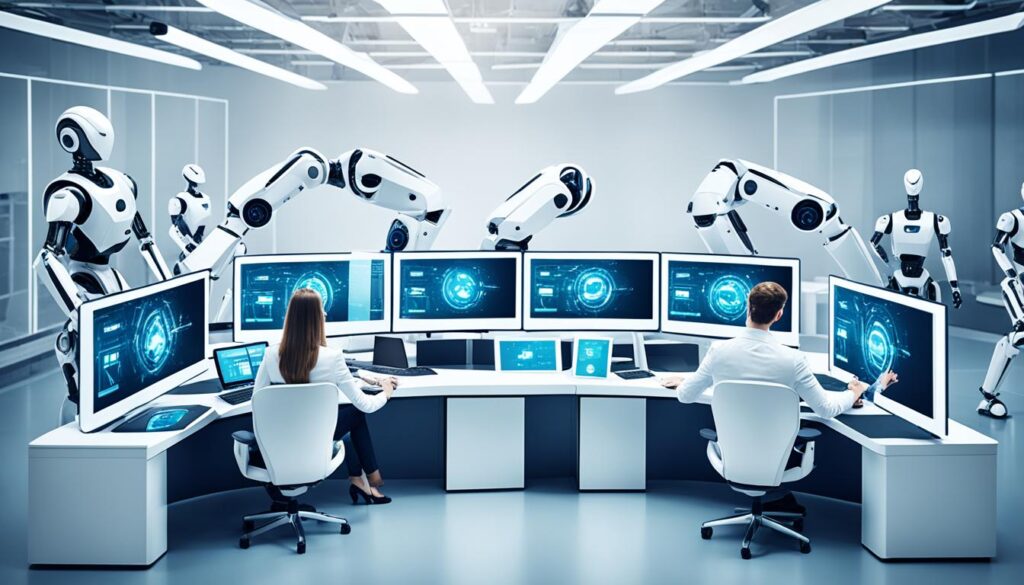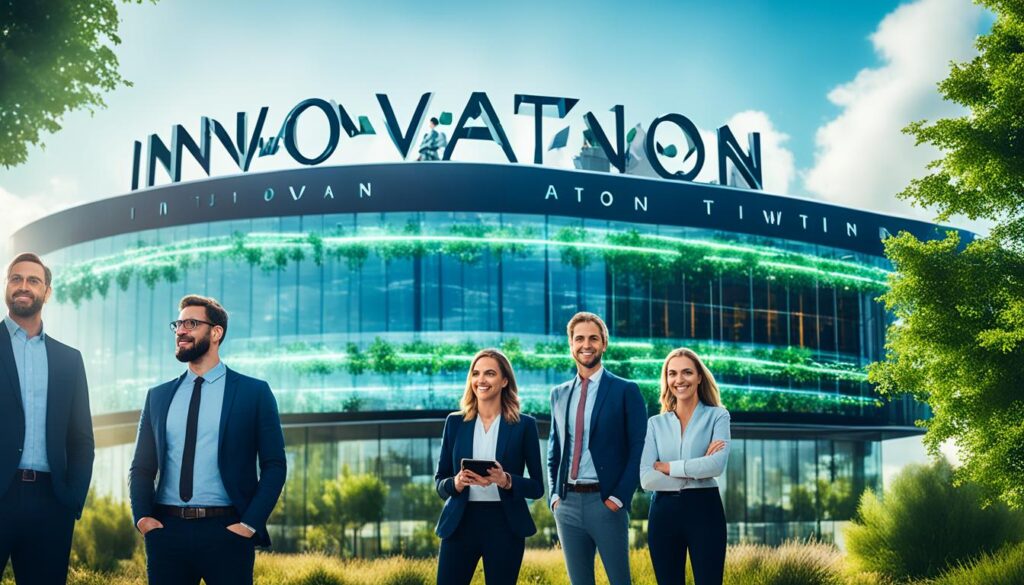“As an Amazon Associate I earn from qualifying purchases.” .
Artificial intelligence (AI) was once just an idea in science fiction. Now, it’s expected to add $15.7 trillion to the world economy by 2030. That’s a big jump, considering only 17% of top business leaders in the U.S. knew about AI a few years back.
The power of AI is changing businesses today. 35% of companies are using AI, boosting global GDP by 14% within the decade. This huge change shows how important AI is for the future. 85% of executives think AI will help them stay ahead in their industries. And 64% say AI has already made their companies more productive.
Key Takeaways
- The predictive impact of AI on the economy with a $15.7 trillion contribution by 2030.
- Rapid adoption trends illustrating that 35% of businesses are already embracing AI.
- How the belief in AI as a competitive asset has become widespread among executives.
- A glimpse into AI’s efficiency-enhancing capabilities with a majority of businesses acknowledging increased productivity.
- Awareness growth from tentative familiarity to strategic integration in leadership circles.
- The strategic role of AI investment and innovation in global economic powerhouses.
- The subtle hand of AI in finance and trading, indicating a transformation of traditional roles.
The Integral Role of AI in Shaping Modern Governments
Governments worldwide are embracing AI’s power. It’s more than just doing tasks faster. AI helps in making smart decisions and engaging people. These efforts are changing how governments work, serve citizens, and make policies. It’s the dawn of a new era marked by better service, honesty, and fast responses.
- AI tools help officials understand big data for smarter choices.
- Chatbots and custom messages make public services better.
- Growing AI skills is key for improving government actions and competitiveness.
In education, the U.S. Department of Education Office of Educational Technology leads with AI. Their work is making learning personalized, thanks to AI’s ability to meet individual student needs. This is changing how teaching and learning happen, making it more natural and intuitive.
| AI Impact | Specific Initiatives | Outcomes |
|---|---|---|
| Enhanced Learning Adaptivity | AI models for personalized student learning experiences | Better engagement and performance through tailored educational content |
| Inclusive Education | Designing AI with inclusivity for students with disabilities | More accessible learning environments and content |
| Trust Building in AI | Criteria and guidelines for trustworthy educational AI systems | Increased confidence in the use of AI among educational professionals and students |
As governments aim for higher efficiency, they also face huge cybersecurity risks. These threats grew 600% during the pandemic. With AI, they can defend proactively, keeping important data and systems safe.
It’s essential for governments to adopt AI wisely and with moral principles. This earns people’s trust and benefits society. Using AI in education, security, and services means taking a big step forward. It shows a commitment to making informed choices and serving the public good.
AI: Beyond a Tool, A Partner in Innovation
The story of the evolution of AI has changed a lot from its beginnings. It used to be just a simple tool. Now, it’s a key player in sparking new ideas across different fields. We need to clear up wrong ideas about AI. This helps us see its true value as an agent of change.
The Evolution and Misconceptions of AI
AI today is much more advanced because of Google’s Transformers in 2017. This progress was a big step forward in understanding human language by machines. However, many people think AI’s data is mostly wrong. While some data from AI might not be accurate, this actually shows a need for better data rules rather than rejecting AI altogether.
The AI world keeps growing, shown by Google’s Vertex AI managing AI models from start to finish. And with the global generative AI market expected to grow massively by 2033, its impact on the economy is clear.
Redefining Productivity and Creativity
AI and productivity go hand in hand. Thanks to new tools like PaLM 2, we can handle big documents easily. And Codey improves code writing by 25%. Google’s Duet AI is making emails better and even creates new images in Google Slides. AI takes care of the boring stuff. This lets us focus on creating new and exciting ideas.
Adopting AI as a Competitive Edge
In today’s competitive world, using AI smartly gives businesses an edge. Google’s work with NVIDIA is making powerful AI tools, like the supercomputer DGX. They are also making AI more cost-effective. Plus, Google is all about using AI in the right way. They ensure data is handled correctly and protect users’ information. Their support for the NAIRR initiative is creating a safer AI environment for everyone.
Almost all business leaders see AI as a game-changer. Yet, only a few are ready to make it a part of their strategy. The future is not just about using AI. It’s about excelling at it. Companies that use AI wisely will lead in innovation and growth.
Looking ahead, we’ll see a shift. We’ll move from just talking about AI’s growth and its edge in competition. The focus will be on fully integrating AI. This is key for excelling in creativity, productivity, and leading the industry.
Tackling the Inevitability of AI Adoption in the Workplace
The work environment is changing fast because of AI adoption. This leads to a big change in the workplace. People are worried about how AI might affect jobs. This calls for a deep look at how workforces might change. The US and the EU worked together on a study about this. It shows how AI is changing things, but these views don’t match official positions.
AI can do many jobs, not just the ones we know. This might make issues like inequality worse. Yet, it can also handle tasks that are not routine. This means AI could affect many kinds of jobs. The OECD gives a clear definition of an AI system. It mentions that these systems can work on their own to achieve certain goals. This is key in how AI fits into workplaces.

The report by the US and the EU talks about how autonomous AI can be. You can read it here. It shows that AI can work without people in some cases. GPT-3 is an example of this. It uses science to do tasks like a human would. This means big changes are coming. AI will not only do tasks for us but also help us think better.
AI learns from new data without being specifically programmed. This is part of machine learning. Here’s a table that shows what AI could do in the workplace:
| Level of Autonomy | Potential Task Transformation |
|---|---|
| Low | Automation of simple tasks, help in analyzing data |
| Medium | Making complex decisions easier, managing difficult workflows |
| High | Working on its own, planning strategically, and bringing new ideas |
The report also stresses the important role of policymakers. Here’s what it says. They need to support AI’s advances while protecting workers and consumers. It’s a balance between allowing innovation and avoiding harm.
AI offers both challenges and opportunities for businesses. But, there is a way to succeed in this new era. By combining human skills with AI’s power, we can redefine work.
Redefining Business Strategies Through AI Applications
The rise of artificial intelligence has started a new era. Now, AI applications in business are essential for making modern business strategies. By adding AI, companies are changing. They are not just better at what they do. They are also changing how they do things.
This change affects many areas of business. AI helps in creating new solutions and making decisions in all sorts of industries.

The Democratization of AI in Corporate Environments
AI is now accessible to all kinds of businesses, big and small. This shift is making it easier for all businesses to use AI. They can tailor it to meet their own needs and tackle unique challenges.
By putting AI into their plans, businesses are creating a new way of working. This combines human smarts with machine learning. The result? Better customer service, more efficient operations, and new markets.
Harnessing AI for Creative Problem-Solving
AI helps solve problems in new ways. It can spot patterns and offer deep insights. This helps tackle tough challenges across industries.
In healthcare, it improves diagnoses. In retail, it makes supply chains work better. AI’s flexibility is key in finding new solutions. It keeps companies ahead in a fast-changing world.
Strategic Integration of AI in Various Business Sectors
AI’s role is clear in many sectors. It helps banks prevent fraud and create personal banking experiences. Manufacturers use it to make factories safer and more efficient.
The 2021 MIT SMR-BCG AI and business strategy report reveals this trend. Success with AI requires investment, smart management, and a team ready to embrace change.
| Year | Insight | Relevance to Integration |
|---|---|---|
| 2019 | Early AI adopters focused on organizational harmonization. | Underlines the necessity for internal alignment for AI benefits. |
| 2020 | Human-machine collaboration is key to leveraging AI. | Emphasizes learning and adaptation on both sides of the AI equation. |
| 2023 | AI’s influence extends to ethical considerations and data management. | Shows the expanding realms where AI must be judiciously managed. |
| 2024 | Effective AI governance aligns KPIs with strategic aspirations. | Points towards the importance of trustworthy metrics to guide AI deployments. |
Only 10% of companies succeed with AI, yet those who do, illustrate AI’s potential to revolutionize business models and create new value propositions.
The use of AI in business will keep leading innovation. Experts like Sam Ransbotham and events like the LG NOVA Innovation Festival highlight this. As reported by NPR to Forbes, the impact of AI on business is huge. It changes everything and is now vital.
AI Artificial Intelligence: Empowering a Bottom-Up Innovation Culture
AI could boost the world economy by $13 trillion in the next decade, says McKinsey. AI and innovation culture are now key for businesses. But, only 8% of firms really make AI a core part of their growth. This shows we need to start thinking differently about AI. It should be the base of our growth and creative efforts, not just a tool.
To really merge fostering innovation with AI into a company, we need to think and act differently. Leaders have to tackle big problems like data being stuck in one place or staff not knowing much about AI. These issues can stop AI from being used well in the whole company.
In areas like farming and banking, AI is making big decisions. It helps get more crops and decides who gets a loan. Showing how AI can change things, if we let it touch every part of a company. This can only happen with a strong innovation culture.
For AI to be a key part of innovation, we must focus on teaching our teams about it. Leaders need to make AI education a priority. Today’s tech lets us do more than ever before. It’s time for businesses to step up with AI.
We need to focus on using AI as much as on the tech itself for it to really work. This means changing how our companies are set up. We want a place where new ideas are welcome and AI helps them grow. This approach will make teams stronger, increase working together, and keep new ideas coming. That’s how to win with AI today.

Ethical AI Deployment and Risk Management
Ethical AI deployment and risk management are vital as AI grows in all sectors. Silicon Valley shows us the balance needed between AI’s power and its risks. It’s important to innovate responsibly and think about AI’s future effects.
AI in the Silicon Valley: A Lesson in Prudence
In Silicon Valley, both big companies and startups have learned to be careful with AI. They use predictive analytics and automated data analysis for better risk management. Sensedia highlights the need for good governance in using AI safely.
AI Case Studies: Successes and Setbacks
AI has improved efficiency in many areas, from healthcare to finance. It has helped diagnose diseases and detect fraud quickly. Through automation, project management has advanced.
Yet, data breaches and attacks on AI show there are still risks. Working together across different fields is necessary to tackle these issues.
Anticipating the Long-term Impacts of AI
The future effects of AI make ethics and compliance essential. Governments and organizations are setting rules to keep AI in check. They want to ensure fairness and responsibility.
Industries see AI as more than tech; it’s a partner with people at its heart. This approach stresses the importance of the human touch in AI design.
Conclusion
We’re at the start of the AI revolution. The evidence points to the vital role of embracing AI for the future. Leaders are now seeing how big AI’s impact can be. It could raise global wealth by $15.7 trillion by 2030. Business investments in AI in the U.S. leaped from $4 billion to $12.2 billion between 2013 and 2014. This jump shows how eager businesses are to use AI.
AI’s big impact is clearer as it spreads across different areas. Look at China’s goal to spend $150 billion on AI by 2030 to boost productivity. In healthcare, AI is changing diagnosis, patient care, and fighting infections. These advancements show AI’s growing role in shaping our future.
AI’s journey has been remarkable since Alan Turing first talked about it. It’s influenced many fields—like trading, health screenings, and more. Despite some worries, AI’s potential keeps growing. It’s a path to progress and innovation. As we think about AI’s past achievements and future challenges, we keep exploring its limitless possibilities.
FAQ
What is AI artificial intelligence?
How is AI shaping various industries?
What is the role of AI in modern governments?
What are the common misconceptions about AI?
How can AI redefine productivity and creativity?
Why is it important to adopt AI as a competitive edge?
How does AI impact job roles and skill requirements?
What are the concerns and challenges associated with AI implementation?
How can organizations effectively navigate workforce dynamics associated with AI?
How can businesses strategically integrate AI into their operations?
How does AI empower a bottom-up innovation culture within organizations?
What are the ethical considerations and risk management associated with AI deployment?
What can be learned from AI initiatives in Silicon Valley?
What are some AI case studies showcasing successes and setbacks?
What are the long-term impacts of AI, and why is proactive planning essential?
Source Links
- https://www.forbes.com/sites/forbestechcouncil/2023/08/15/shaping-the-ai-future-a-shared-journey/
- https://www.brookings.edu/articles/how-artificial-intelligence-is-transforming-the-world/
- https://tech.ed.gov/ai/
- https://www.forbes.com/sites/ashleystahl/2021/03/10/how-ai-will-impact-the-future-of-work-and-life/
- https://carnegieendowment.org/2019/01/22/we-need-to-get-smart-about-how-governments-use-ai-pub-78179
- https://www.ghd.com/en/insights/beyond-ai
- https://techaisle.com/blog/545-ai-beyond-boundaries-google-s-approach-to-generative-ai
- https://new.nsf.gov/news/democratizing-future-ai-rd-nsf-launch-national-ai
- https://www.whitehouse.gov/wp-content/uploads/2022/12/TTC-EC-CEA-AI-Report-12052022-1.pdf
- https://sloanreview.mit.edu/big-ideas/artificial-intelligence-business-strategy/
- https://www.hbr.org/2019/07/building-the-ai-powered-organization
- https://www.linkedin.com/pulse/ethics-ai-project-management-isla-walls-uh7se
- https://www.sensedia.com/post/responsible-ai-what-is-the-need-for-ethical-ai-deployment
- https://ai.wharton.upenn.edu/white-paper/artificial-intelligence-risk-governance/
- https://www.ncbi.nlm.nih.gov/pmc/articles/PMC6691444/
- https://www.iep.utm.edu/ethics-of-artificial-intelligence/
“As an Amazon Associate I earn from qualifying purchases.” .



